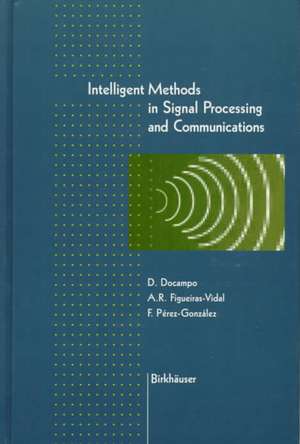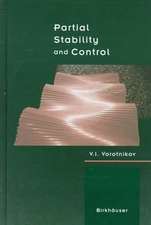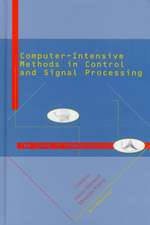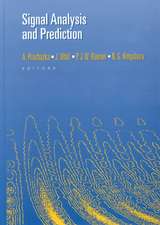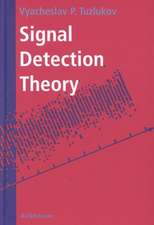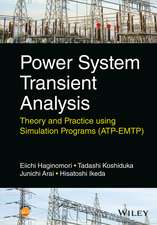Intelligent Methods in Signal Processing and Communications
Editat de Domingo DoCampo, Anibal Figueiras-Vidal, Fernando Perez-Gonzálezen Limba Engleză Hardback – mai 1997
| Toate formatele și edițiile | Preț | Express |
|---|---|---|
| Paperback (1) | 390.63 lei 6-8 săpt. | |
| Birkhäuser Boston – 12 oct 2012 | 390.63 lei 6-8 săpt. | |
| Hardback (1) | 401.24 lei 6-8 săpt. | |
| Birkhäuser Boston – mai 1997 | 401.24 lei 6-8 săpt. |
Preț: 401.24 lei
Nou
Puncte Express: 602
Preț estimativ în valută:
76.78€ • 82.10$ • 64.02£
76.78€ • 82.10$ • 64.02£
Carte tipărită la comandă
Livrare economică 17 aprilie-01 mai
Preluare comenzi: 021 569.72.76
Specificații
ISBN-13: 9780817639600
ISBN-10: 0817639608
Pagini: 318
Ilustrații: XVI, 318 p.
Dimensiuni: 155 x 235 x 23 mm
Greutate: 0.73 kg
Ediția:1997
Editura: Birkhäuser Boston
Colecția Birkhäuser
Locul publicării:Boston, MA, United States
ISBN-10: 0817639608
Pagini: 318
Ilustrații: XVI, 318 p.
Dimensiuni: 155 x 235 x 23 mm
Greutate: 0.73 kg
Ediția:1997
Editura: Birkhäuser Boston
Colecția Birkhäuser
Locul publicării:Boston, MA, United States
Public țintă
ResearchCuprins
1 Adaptive Antenna Arrays in Mobile Communications.- 1.1 Introduction.- 1.2 Adaptive Arrays in Base Station Antennas.- 1.3 Adaptive Array Details.- 1.4 LMS Adaptive Array Examples.- 1.5 Desired Signal Availability.- 1.6 Discussion and Observations.- 1.7 References.- 2 Demodulation in the Presence of Multiuser Interference: Progress and Misconceptions.- 2.1 Introduction.- 2.2 Single-user Matched Filter.- 2.3 Optimum Multiuser Detection.- 2.4 Linear Multiuser Detection.- 2.5 Decision-based Multiuser Detection.- 2.6 Noncoherent Multiuser Detection.- 2.7 Multiuser Detection combined with Array Processing.- 2.8 Multiuser Detection with Error Control Coded Data.- 2.9 References.- 3 Intelligent Signal Detection.- 3.1 Introduction.- 3.2 Three Basic Elements Of The Intelligent Detection System.- 3.3 Neural Network-Based Two-Channel Receiver.- 3.4 Rationale For The Modular Detection Strategy.- 3.5 Case Study.- 3.6 Summary And Discussion.- 3.7 References.- 4 Biometric Identification for Access Control.- 4.1 Introduction.- 4.2 Feature Extraction for Biometric Identification.- 4.3 Pattern Classification for Biometric Identification.- 4.4 Probabilistic Decision-Based Neural Network.- 4.5 Biometric Identification by Human Faces.- 4.6 Biometric Identification by Palm Prints.- 4.7 Concluding Remarks.- 4.8 References.- 5 Multidimensional Nonlinear Myopic Maps, Volterra Series, and Uniform Neural-Network Approximations.- 5.1 Introduction.- 5.2 Approximation of Myopic Maps.- 5.3 Appendices.- 5.4 References.- 6 Monotonicity: Theory and Implementation.- 6.1 Introduction.- 6.2 Representation of hints.- 6.3 Monotonicity hints.- 6.4 Theory.- 6.5 Conclusion.- 6.6 References.- 7 Analysis and Synthesis Tools for Robust SPRness.- 7.1 Introduction.- 7.2 SPR Analysis of Uncertain Systems.- 7.3 Synthesis of LTI Filters for Robust SPR Problems.- 7.4 Experimental results.- 7.5 Conclusions.- 7.6 References.- 8 Boundary Methods for Distribution Analysis.- 8.1 Introduction.- 8.2 Motivation.- 8.3 Boundary Methods as Feature-Set Evaluation.- 8.4 Boundary Methods as a Sample-Pruning (SP) Mechanism.- 8.5 Boundary Methods as Fisher’s Linear Discriminant (FLD)..- 8.6 Conclusions.- 8.7 Apendix: Proof of the Theorem Relating FLD and Boundary Methods.- 8.8 References.- 9 Constructive Function Approximation: Theory and Practice.- 9.1 Introduction.- 9.2 Overview of Constructive Approximation.- 9.3 Constructive Solutions.- 9.4 Limits and Bounds of the Approximation.- 9.5 The Sigmoidal Class of Approximators.- 9.6 Practical Considerations.- 9.7 Conclusions.- 9.8 Acknowledgments.- 9.9 References.- 10 Decision Trees Based on Neural Networks.- 10.1 Introduction.- 10.2 Adaptive modular classifiers.- 10.3 A survey on tree classification.- 10.4 Neural Decision Trees.- 10.5 Hierarchical mixtures of experts.- 10.6 Lighting the hidden variables.- 10.7 Conclusions.- 10.8 References.- 11 Applications of Chaos in Communications.- 11.1 Introduction.- 11.2 Deterministic dynamical systems and chaos.- 11.3 Chua’s oscillator: a paradigm for chaos.- 11.4 Periodicity, quasiperiodicity, and chaos.- 11.5 Applications of chaos in communications.- 11.6 Digital communication.- 11.7 Spreading.- 11.8 Chaotic synchronization: state of the art.- 11.9 Chaotic modulation: state of the art.- 11.10Chaotic demodulation: state of the art.- 11.11Additional considerations.- 11.12Engineering challenges.- 11.13References.- 12 Design of Near PR Non-Uniform Filter Banks.- 12.1 Introduction.- 12.2 The MPEG audio coder.- 12.3 Non-uniform filter banks with rational sampling factors.- 12.4 Examples of non-uniform filterbanks design.- 12.5 Conclusions.- 12.6 References.- 13 Source Coding of Stereo Pairs.- 13.1 Introduction.- 13.2 Stereo Image Coding.- 13.3 The Subspace Projection Technique.- 13.4 Experimental Results.- 13.5 Conclusion.- 13.6 References.- 14 Design Methodology for VLSI Implementation of Image and Video Coding Algorithms — A Case Study.- 14.1 Introduction.- 14.2 JPEG Baseline Algorithm.- 14.3 High Level Modeling.- 14.4 VLSI Architectures.- 14.5 Bit-true Level Modeling.- 14.6 Layout Design.- 14.7 Results.- 14.8 Conclusions.- 14.9 Acknowledgements.- 14. l0 References.
